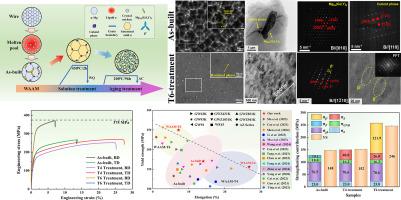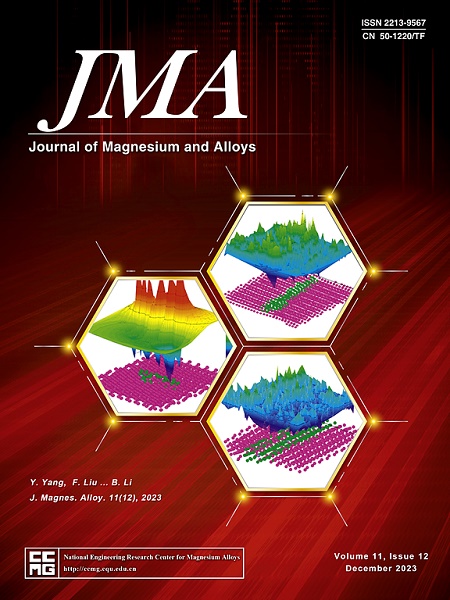Excellent strength-ductility synergy property of wire-arc additively manufactured Mg-Gd-Y-Zr alloy investigated by heat treatment
IF 13.8
1区 材料科学
Q1 METALLURGY & METALLURGICAL ENGINEERING
引用次数: 0
Abstract
In this work, the GW63K (Mg-6.54Gd-3.93Y-0.41Zr, wt.%) alloy wire was utilized as the feedstock material and the thin-walled component was fabricated using wire-arc additive manufacturing technology (WAAM). The microstructural evolution during deposition and subsequent heat treatment was explained through multi-scale microstructural characterization techniques, and the impact of heat treatment on the strength-ductility synergy of the deposited alloy was systematically compared. The results showed that the microstructure of the deposited sample was mainly composed of fine equiaxed α-Mg grains and Mg24(Gd,Y)5 phase. The optimized solution heat treatment (450 °C × 2 h) had little effect on the grain size, but can effectively reduce the Mg24(Gd,Y)5 eutectic phase on the grain boundary, resulting in a significant increase in elongation from 13.7% to 26.6%. After peak-aging treatment, the strength of the GW63K alloy increased to 370 MPa, which was significantly higher than the as-built state (267 MPa). The superior strength in this study is attributed to the refinement strengthening imparted by the fine microstructure inherited in the as-built GW63K alloy, as well as the precipitation strengthening due to the formation of dense β' precipitates with a pronounced plate-like aspect ratio.


通过热处理研究了丝弧增材制备Mg-Gd-Y-Zr合金优异的强度-塑性协同性能
本文以GW63K (Mg-6.54Gd-3.93Y-0.41Zr, wt.%)合金丝为原料,采用线弧增材制造技术(WAAM)制备薄壁构件。通过多尺度显微组织表征技术解释了沉积和后续热处理过程中的显微组织演变,并系统比较了热处理对沉积合金强度-塑性协同效应的影响。结果表明:沉积试样的显微组织主要由细小的等轴α-Mg晶粒和Mg24(Gd,Y)5相组成;优化后的固溶热处理(450°C × 2 h)对晶粒尺寸影响不大,但能有效减少晶界上的Mg24(Gd,Y)5共晶相,使延伸率从13.7%显著提高到26.6%。峰时效处理后,GW63K合金的强度达到370 MPa,明显高于铸态(267 MPa)。在本研究中,优异的强度归因于GW63K合金中继承的精细组织所带来的细化强化,以及由于形成致密的具有明显板状长径比的β′相而产生的析出强化。
本文章由计算机程序翻译,如有差异,请以英文原文为准。
求助全文
约1分钟内获得全文
求助全文
来源期刊

Journal of Magnesium and Alloys
Engineering-Mechanics of Materials
CiteScore
20.20
自引率
14.80%
发文量
52
审稿时长
59 days
期刊介绍:
The Journal of Magnesium and Alloys serves as a global platform for both theoretical and experimental studies in magnesium science and engineering. It welcomes submissions investigating various scientific and engineering factors impacting the metallurgy, processing, microstructure, properties, and applications of magnesium and alloys. The journal covers all aspects of magnesium and alloy research, including raw materials, alloy casting, extrusion and deformation, corrosion and surface treatment, joining and machining, simulation and modeling, microstructure evolution and mechanical properties, new alloy development, magnesium-based composites, bio-materials and energy materials, applications, and recycling.
 求助内容:
求助内容: 应助结果提醒方式:
应助结果提醒方式:


